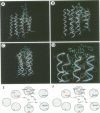Abstract
Human somatostatin receptor subtypes (SSTR1-5) bind their natural ligands SRIF-14 and SRIF-28 with high affinity. By contrast, short synthetic SRIF analogues such as SMS 201-995, a peptide agonist used for the treatment of various endocrine and malignant disorders, display sub-nanomolar affinity only for the receptor subtype SSTR2. To understand the molecular nature of selective peptide agonist binding to somatostatin receptors we have now, by site-directed mutagenesis, identified amino acids mediating SMS 201-995 specificity for SSTR2. Sequentially, amino acids in SSTR1, a receptor subtype exhibiting low affinity for SMS 201-995, were exchanged for the corresponding SSTR2 residues. After three consecutive steps, in which eight amino acids were exchanged, a SSTR1 mutant receptor with high affinity for SMS 201-995 was obtained. Receptor mutants with different combinations of these eight amino acids were then constructed. A single Ser305 to Phe mutation in TM VII increased the affinity of SSTR1 for SMS 201-995 nearly 100-fold. When this mutation was combined with an exchange of Gln291 to Asn in TM VI, almost full susceptibility to SMS 201-995 was obtained. Thus, it is concluded that the specificity of SMS 201-995 for SSTR2 is mainly defined by these two amino acids in transmembrane domains VI and VII. Using the conjugate gradient method we have, by analogy to the well established structure of bacteriorhodopsin, built a model for SRIF receptor-ligand interactions that explains the importance of Gln291 and Ser305 for the selectivity of agonists.
Full text
PDF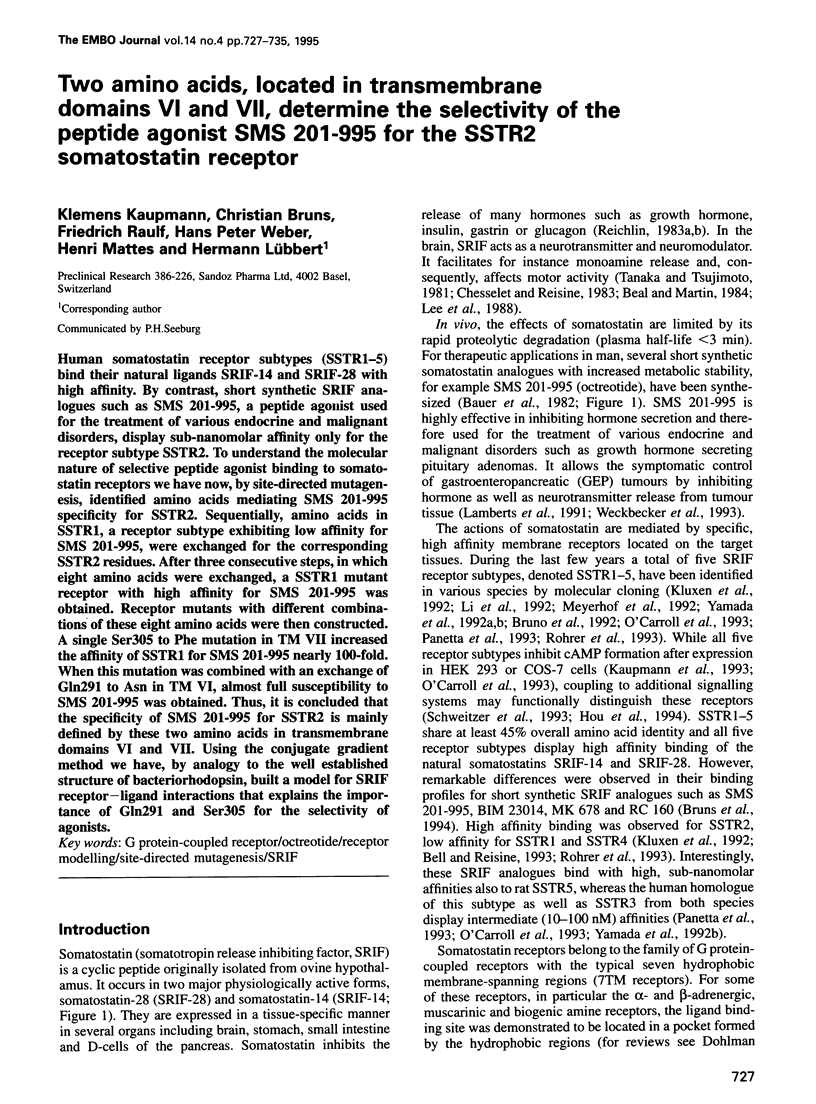
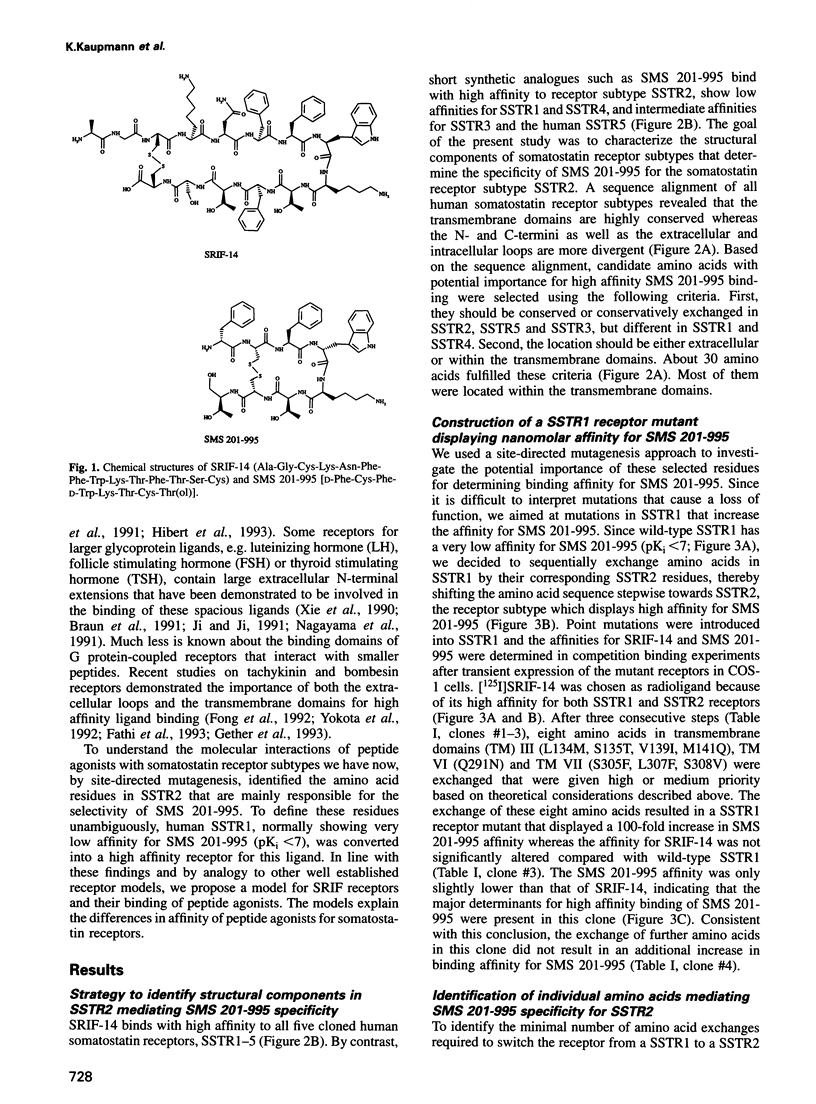

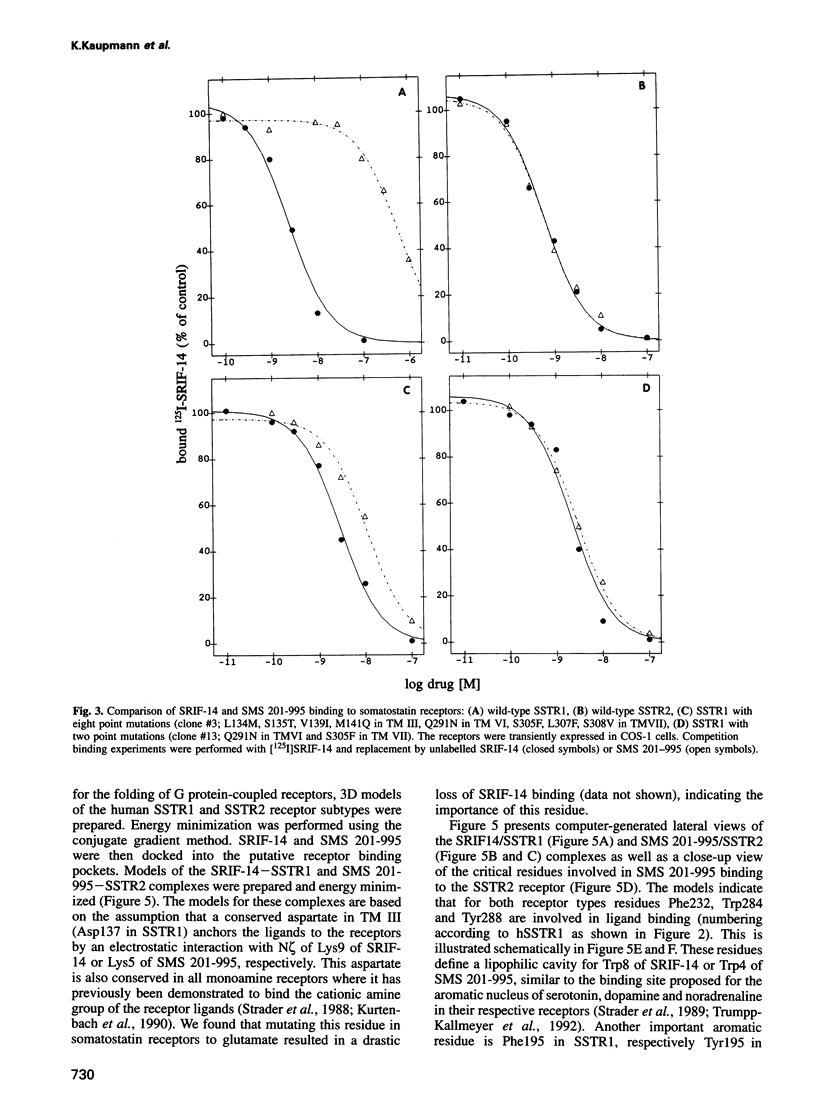
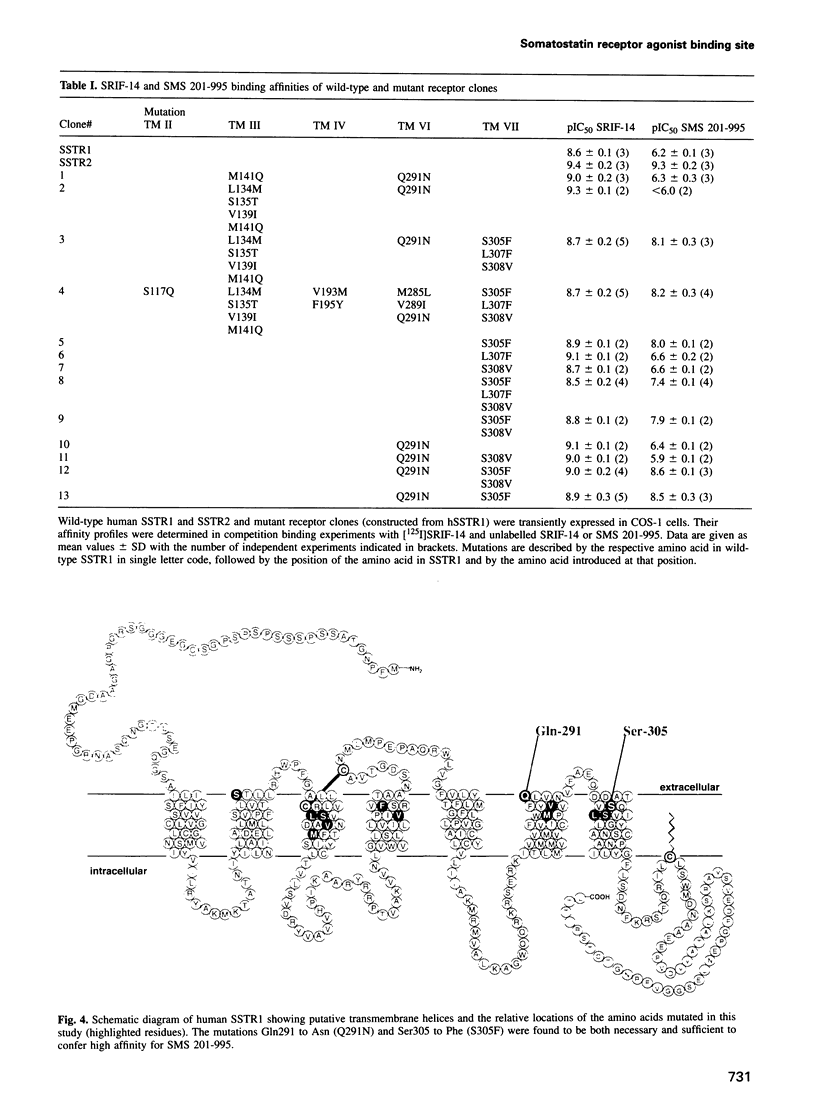
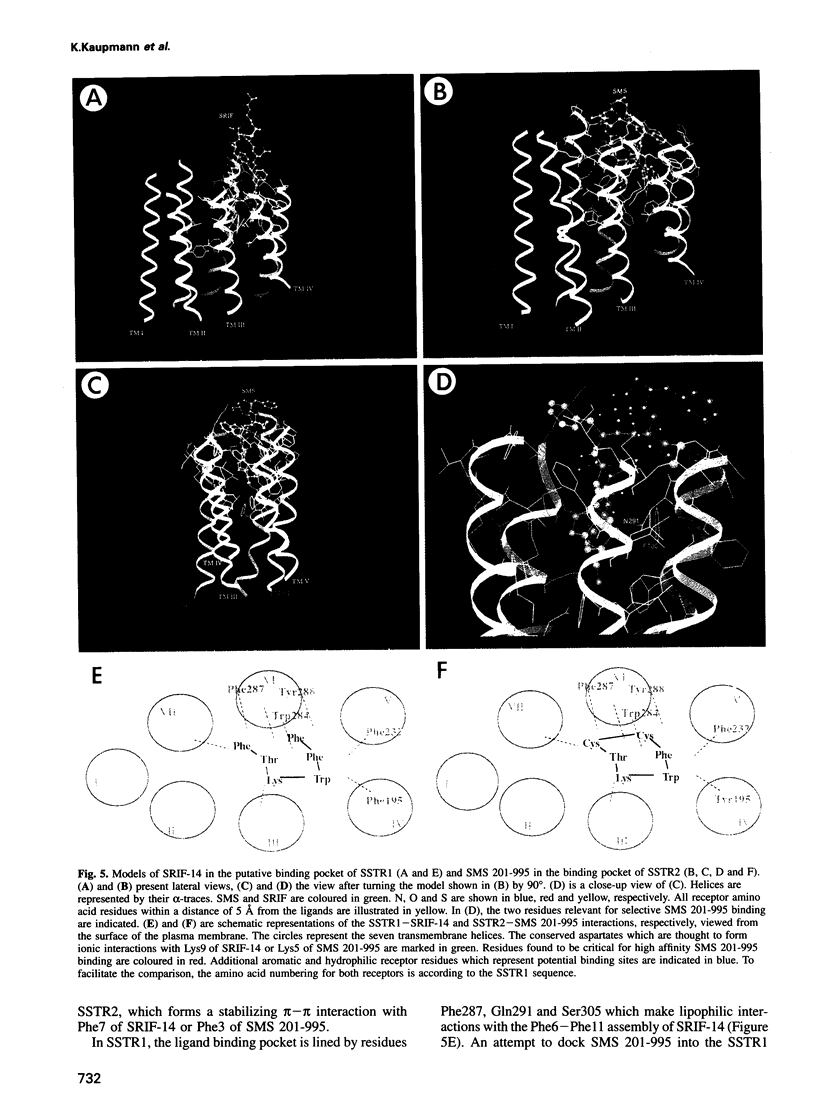

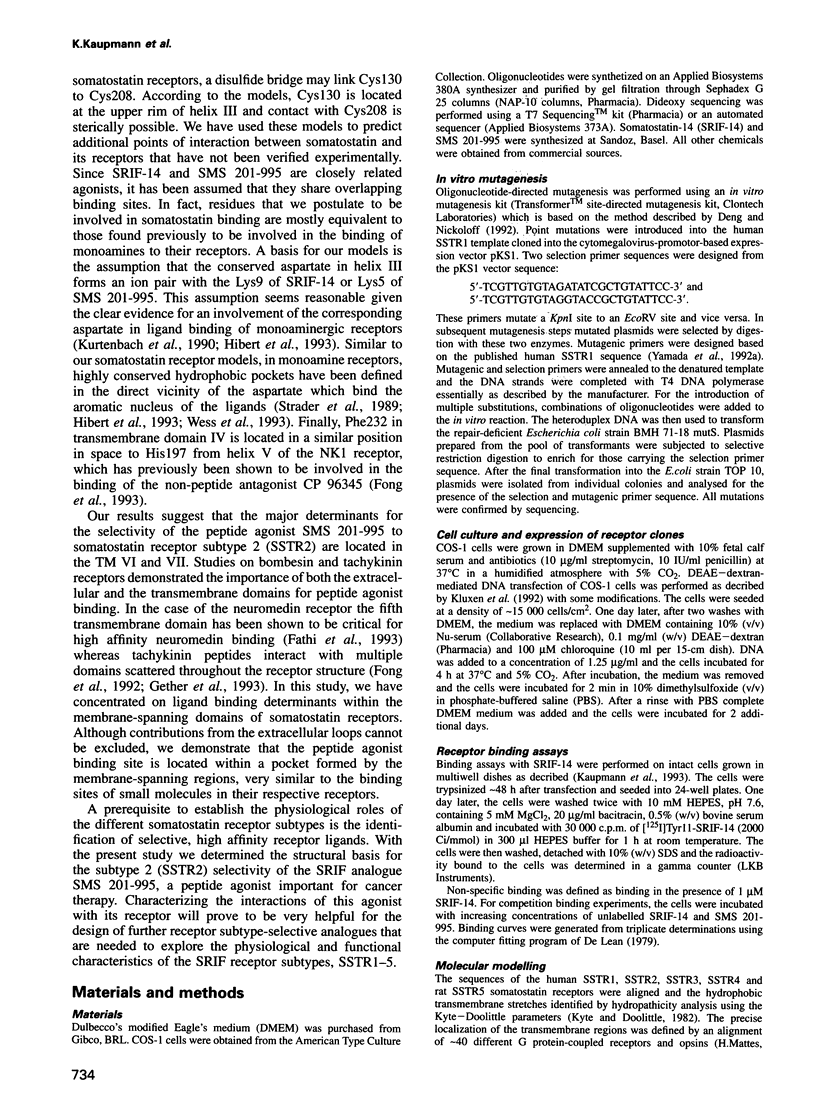
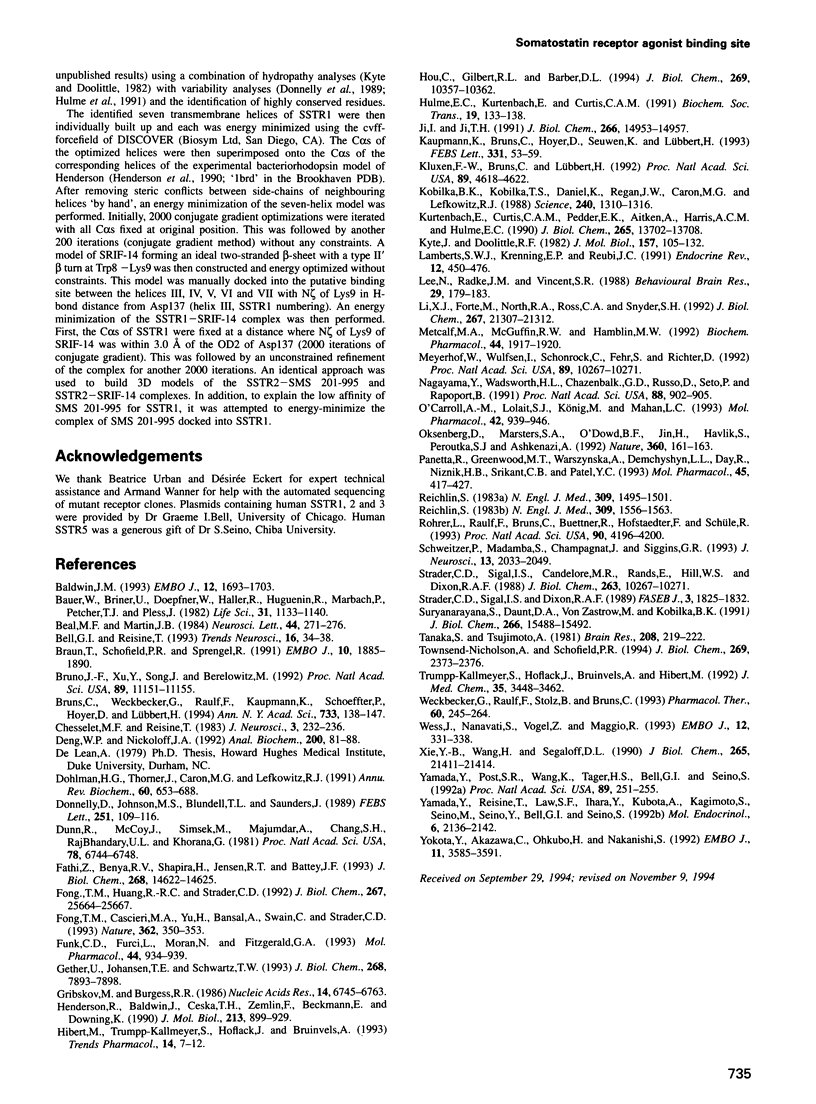
Images in this article
Selected References
These references are in PubMed. This may not be the complete list of references from this article.
- Baldwin J. M. The probable arrangement of the helices in G protein-coupled receptors. EMBO J. 1993 Apr;12(4):1693–1703. doi: 10.1002/j.1460-2075.1993.tb05814.x. [DOI] [PMC free article] [PubMed] [Google Scholar]
- Bauer W., Briner U., Doepfner W., Haller R., Huguenin R., Marbach P., Petcher T. J., Pless SMS 201-995: a very potent and selective octapeptide analogue of somatostatin with prolonged action. Life Sci. 1982 Sep 13;31(11):1133–1140. doi: 10.1016/0024-3205(82)90087-x. [DOI] [PubMed] [Google Scholar]
- Beal M. F., Martin J. B. The effect of somatostatin on striatal catecholamines. Neurosci Lett. 1984 Feb 24;44(3):271–276. doi: 10.1016/0304-3940(84)90034-x. [DOI] [PubMed] [Google Scholar]
- Bell G. I., Reisine T. Molecular biology of somatostatin receptors. Trends Neurosci. 1993 Jan;16(1):34–38. doi: 10.1016/0166-2236(93)90050-v. [DOI] [PubMed] [Google Scholar]
- Braun T., Schofield P. R., Sprengel R. Amino-terminal leucine-rich repeats in gonadotropin receptors determine hormone selectivity. EMBO J. 1991 Jul;10(7):1885–1890. doi: 10.1002/j.1460-2075.1991.tb07714.x. [DOI] [PMC free article] [PubMed] [Google Scholar]
- Bruno J. F., Xu Y., Song J., Berelowitz M. Molecular cloning and functional expression of a brain-specific somatostatin receptor. Proc Natl Acad Sci U S A. 1992 Dec 1;89(23):11151–11155. doi: 10.1073/pnas.89.23.11151. [DOI] [PMC free article] [PubMed] [Google Scholar]
- Bruns C., Weckbecker G., Raulf F., Kaupmann K., Schoeffter P., Hoyer D., Lübbert H. Molecular pharmacology of somatostatin-receptor subtypes. Ann N Y Acad Sci. 1994 Sep 15;733:138–146. doi: 10.1111/j.1749-6632.1994.tb17263.x. [DOI] [PubMed] [Google Scholar]
- Chesselet M. F., Reisine T. D. Somatostatin regulates dopamine release in rat striatal slices and cat caudate nuclei. J Neurosci. 1983 Jan;3(1):232–236. doi: 10.1523/JNEUROSCI.03-01-00232.1983. [DOI] [PMC free article] [PubMed] [Google Scholar]
- Deng W. P., Nickoloff J. A. Site-directed mutagenesis of virtually any plasmid by eliminating a unique site. Anal Biochem. 1992 Jan;200(1):81–88. doi: 10.1016/0003-2697(92)90280-k. [DOI] [PubMed] [Google Scholar]
- Dohlman H. G., Thorner J., Caron M. G., Lefkowitz R. J. Model systems for the study of seven-transmembrane-segment receptors. Annu Rev Biochem. 1991;60:653–688. doi: 10.1146/annurev.bi.60.070191.003253. [DOI] [PubMed] [Google Scholar]
- Donnelly D., Johnson M. S., Blundell T. L., Saunders J. An analysis of the periodicity of conserved residues in sequence alignments of G-protein coupled receptors. Implications for the three-dimensional structure. FEBS Lett. 1989 Jul 17;251(1-2):109–116. doi: 10.1016/0014-5793(89)81438-3. [DOI] [PubMed] [Google Scholar]
- Dunn R., McCoy J., Simsek M., Majumdar A., Chang S. H., Rajbhandary U. L., Khorana H. G. The bacteriorhodopsin gene. Proc Natl Acad Sci U S A. 1981 Nov;78(11):6744–6748. doi: 10.1073/pnas.78.11.6744. [DOI] [PMC free article] [PubMed] [Google Scholar]
- Fathi Z., Benya R. V., Shapira H., Jensen R. T., Battey J. F. The fifth transmembrane segment of the neuromedin B receptor is critical for high affinity neuromedin B binding. J Biol Chem. 1993 Jul 15;268(20):14622–14626. [PubMed] [Google Scholar]
- Fong T. M., Cascieri M. A., Yu H., Bansal A., Swain C., Strader C. D. Amino-aromatic interaction between histidine 197 of the neurokinin-1 receptor and CP 96345. Nature. 1993 Mar 25;362(6418):350–353. doi: 10.1038/362350a0. [DOI] [PubMed] [Google Scholar]
- Fong T. M., Huang R. R., Strader C. D. Localization of agonist and antagonist binding domains of the human neurokinin-1 receptor. J Biol Chem. 1992 Dec 25;267(36):25664–25667. [PubMed] [Google Scholar]
- Funk C. D., Furci L., Moran N., Fitzgerald G. A. Point mutation in the seventh hydrophobic domain of the human thromboxane A2 receptor allows discrimination between agonist and antagonist binding sites. Mol Pharmacol. 1993 Nov;44(5):934–939. [PubMed] [Google Scholar]
- Gether U., Johansen T. E., Schwartz T. W. Chimeric NK1 (substance P)/NK3 (neurokinin B) receptors. Identification of domains determining the binding specificity of tachykinin agonists. J Biol Chem. 1993 Apr 15;268(11):7893–7898. [PubMed] [Google Scholar]
- Gribskov M., Burgess R. R. Sigma factors from E. coli, B. subtilis, phage SP01, and phage T4 are homologous proteins. Nucleic Acids Res. 1986 Aug 26;14(16):6745–6763. doi: 10.1093/nar/14.16.6745. [DOI] [PMC free article] [PubMed] [Google Scholar]
- Henderson R., Baldwin J. M., Ceska T. A., Zemlin F., Beckmann E., Downing K. H. Model for the structure of bacteriorhodopsin based on high-resolution electron cryo-microscopy. J Mol Biol. 1990 Jun 20;213(4):899–929. doi: 10.1016/S0022-2836(05)80271-2. [DOI] [PubMed] [Google Scholar]
- Hibert M. F., Trumpp-Kallmeyer S., Hoflack J., Bruinvels A. This is not a G protein-coupled receptor. Trends Pharmacol Sci. 1993 Jan;14(1):7–12. doi: 10.1016/0165-6147(93)90106-t. [DOI] [PubMed] [Google Scholar]
- Hou C., Gilbert R. L., Barber D. L. Subtype-specific signaling mechanisms of somatostatin receptors SSTR1 and SSTR2. J Biol Chem. 1994 Apr 8;269(14):10357–10362. [PubMed] [Google Scholar]
- Hulme E. C., Kurtenbach E., Curtis C. A. Muscarinic acetylcholine receptors: structure and function. Biochem Soc Trans. 1991 Feb;19(1):133–138. doi: 10.1042/bst0190133. [DOI] [PubMed] [Google Scholar]
- Ji I., Ji T. H. Asp383 in the second transmembrane domain of the lutropin receptor is important for high affinity hormone binding and cAMP production. J Biol Chem. 1991 Aug 15;266(23):14953–14957. [PubMed] [Google Scholar]
- Kaupmann K., Bruns C., Hoyer D., Seuwen K., Lübbert H. Distribution and second messenger coupling of four somatostatin receptor subtypes expressed in brain. FEBS Lett. 1993 Sep 27;331(1-2):53–59. doi: 10.1016/0014-5793(93)80296-7. [DOI] [PubMed] [Google Scholar]
- Kluxen F. W., Bruns C., Lübbert H. Expression cloning of a rat brain somatostatin receptor cDNA. Proc Natl Acad Sci U S A. 1992 May 15;89(10):4618–4622. doi: 10.1073/pnas.89.10.4618. [DOI] [PMC free article] [PubMed] [Google Scholar]
- Kobilka B. K., Kobilka T. S., Daniel K., Regan J. W., Caron M. G., Lefkowitz R. J. Chimeric alpha 2-,beta 2-adrenergic receptors: delineation of domains involved in effector coupling and ligand binding specificity. Science. 1988 Jun 3;240(4857):1310–1316. doi: 10.1126/science.2836950. [DOI] [PubMed] [Google Scholar]
- Kurtenbach E., Curtis C. A., Pedder E. K., Aitken A., Harris A. C., Hulme E. C. Muscarinic acetylcholine receptors. Peptide sequencing identifies residues involved in antagonist binding and disulfide bond formation. J Biol Chem. 1990 Aug 15;265(23):13702–13708. [PubMed] [Google Scholar]
- Kyte J., Doolittle R. F. A simple method for displaying the hydropathic character of a protein. J Mol Biol. 1982 May 5;157(1):105–132. doi: 10.1016/0022-2836(82)90515-0. [DOI] [PubMed] [Google Scholar]
- Lamberts S. W., Krenning E. P., Reubi J. C. The role of somatostatin and its analogs in the diagnosis and treatment of tumors. Endocr Rev. 1991 Nov;12(4):450–482. doi: 10.1210/edrv-12-4-450. [DOI] [PubMed] [Google Scholar]
- Lee N., Radke J. M., Vincent S. R. Intra-cerebral cysteamine infusions attenuate the motor response to dopaminergic agonists. Behav Brain Res. 1988 Jul;29(1-2):179–183. doi: 10.1016/0166-4328(88)90065-4. [DOI] [PubMed] [Google Scholar]
- Li X. J., Forte M., North R. A., Ross C. A., Snyder S. H. Cloning and expression of a rat somatostatin receptor enriched in brain. J Biol Chem. 1992 Oct 25;267(30):21307–21312. [PubMed] [Google Scholar]
- Metcalf M. A., McGuffin R. W., Hamblin M. W. Conversion of the human 5-HT1D beta serotonin receptor to the rat 5-HT1B ligand-binding phenotype by Thr355Asn site directed mutagenesis. Biochem Pharmacol. 1992 Nov 17;44(10):1917–1920. doi: 10.1016/0006-2952(92)90092-w. [DOI] [PubMed] [Google Scholar]
- Meyerhof W., Wulfsen I., Schönrock C., Fehr S., Richter D. Molecular cloning of a somatostatin-28 receptor and comparison of its expression pattern with that of a somatostatin-14 receptor in rat brain. Proc Natl Acad Sci U S A. 1992 Nov 1;89(21):10267–10271. doi: 10.1073/pnas.89.21.10267. [DOI] [PMC free article] [PubMed] [Google Scholar]
- Nagayama Y., Wadsworth H. L., Chazenbalk G. D., Russo D., Seto P., Rapoport B. Thyrotropin-luteinizing hormone/chorionic gonadotropin receptor extracellular domain chimeras as probes for thyrotropin receptor function. Proc Natl Acad Sci U S A. 1991 Feb 1;88(3):902–905. doi: 10.1073/pnas.88.3.902. [DOI] [PMC free article] [PubMed] [Google Scholar]
- O'Carroll A. M., Lolait S. J., König M., Mahan L. C. Molecular cloning and expression of a pituitary somatostatin receptor with preferential affinity for somatostatin-28. Mol Pharmacol. 1992 Dec;42(6):939–946. [PubMed] [Google Scholar]
- Oksenberg D., Marsters S. A., O'Dowd B. F., Jin H., Havlik S., Peroutka S. J., Ashkenazi A. A single amino-acid difference confers major pharmacological variation between human and rodent 5-HT1B receptors. Nature. 1992 Nov 12;360(6400):161–163. doi: 10.1038/360161a0. [DOI] [PubMed] [Google Scholar]
- Panetta R., Greenwood M. T., Warszynska A., Demchyshyn L. L., Day R., Niznik H. B., Srikant C. B., Patel Y. C. Molecular cloning, functional characterization, and chromosomal localization of a human somatostatin receptor (somatostatin receptor type 5) with preferential affinity for somatostatin-28. Mol Pharmacol. 1994 Mar;45(3):417–427. [PubMed] [Google Scholar]
- Reichlin S. Somatostatin (second of two parts). N Engl J Med. 1983 Dec 22;309(25):1556–1563. doi: 10.1056/NEJM198312223092506. [DOI] [PubMed] [Google Scholar]
- Reichlin S. Somatostatin. N Engl J Med. 1983 Dec 15;309(24):1495–1501. doi: 10.1056/NEJM198312153092406. [DOI] [PubMed] [Google Scholar]
- Rohrer L., Raulf F., Bruns C., Buettner R., Hofstaedter F., Schüle R. Cloning and characterization of a fourth human somatostatin receptor. Proc Natl Acad Sci U S A. 1993 May 1;90(9):4196–4200. doi: 10.1073/pnas.90.9.4196. [DOI] [PMC free article] [PubMed] [Google Scholar]
- Schweitzer P., Madamba S., Champagnat J., Siggins G. R. Somatostatin inhibition of hippocampal CA1 pyramidal neurons: mediation by arachidonic acid and its metabolites. J Neurosci. 1993 May;13(5):2033–2049. doi: 10.1523/JNEUROSCI.13-05-02033.1993. [DOI] [PMC free article] [PubMed] [Google Scholar]
- Strader C. D., Sigal I. S., Candelore M. R., Rands E., Hill W. S., Dixon R. A. Conserved aspartic acid residues 79 and 113 of the beta-adrenergic receptor have different roles in receptor function. J Biol Chem. 1988 Jul 25;263(21):10267–10271. [PubMed] [Google Scholar]
- Strader C. D., Sigal I. S., Dixon R. A. Structural basis of beta-adrenergic receptor function. FASEB J. 1989 May;3(7):1825–1832. doi: 10.1096/fasebj.3.7.2541037. [DOI] [PubMed] [Google Scholar]
- Suryanarayana S., Daunt D. A., Von Zastrow M., Kobilka B. K. A point mutation in the seventh hydrophobic domain of the alpha 2 adrenergic receptor increases its affinity for a family of beta receptor antagonists. J Biol Chem. 1991 Aug 15;266(23):15488–15492. [PubMed] [Google Scholar]
- Tanaka S., Tsujimoto A. Somatostatin facilitates the serotonin release from rat cerebral cortex, hippocampus and hypothalamus slices. Brain Res. 1981 Mar 9;208(1):219–222. doi: 10.1016/0006-8993(81)90636-3. [DOI] [PubMed] [Google Scholar]
- Townsend-Nicholson A., Schofield P. R. A threonine residue in the seventh transmembrane domain of the human A1 adenosine receptor mediates specific agonist binding. J Biol Chem. 1994 Jan 28;269(4):2373–2376. [PubMed] [Google Scholar]
- Trumpp-Kallmeyer S., Hoflack J., Bruinvels A., Hibert M. Modeling of G-protein-coupled receptors: application to dopamine, adrenaline, serotonin, acetylcholine, and mammalian opsin receptors. J Med Chem. 1992 Sep 18;35(19):3448–3462. doi: 10.1021/jm00097a002. [DOI] [PubMed] [Google Scholar]
- Weckbecker G., Raulf F., Stolz B., Bruns C. Somatostatin analogs for diagnosis and treatment of cancer. Pharmacol Ther. 1993 Nov;60(2):245–264. doi: 10.1016/0163-7258(93)90009-3. [DOI] [PubMed] [Google Scholar]
- Wess J., Nanavati S., Vogel Z., Maggio R. Functional role of proline and tryptophan residues highly conserved among G protein-coupled receptors studied by mutational analysis of the m3 muscarinic receptor. EMBO J. 1993 Jan;12(1):331–338. doi: 10.1002/j.1460-2075.1993.tb05661.x. [DOI] [PMC free article] [PubMed] [Google Scholar]
- Xie Y. B., Wang H., Segaloff D. L. Extracellular domain of lutropin/choriogonadotropin receptor expressed in transfected cells binds choriogonadotropin with high affinity. J Biol Chem. 1990 Dec 15;265(35):21411–21414. [PubMed] [Google Scholar]
- Yamada Y., Post S. R., Wang K., Tager H. S., Bell G. I., Seino S. Cloning and functional characterization of a family of human and mouse somatostatin receptors expressed in brain, gastrointestinal tract, and kidney. Proc Natl Acad Sci U S A. 1992 Jan 1;89(1):251–255. doi: 10.1073/pnas.89.1.251. [DOI] [PMC free article] [PubMed] [Google Scholar]
- Yamada Y., Reisine T., Law S. F., Ihara Y., Kubota A., Kagimoto S., Seino M., Seino Y., Bell G. I., Seino S. Somatostatin receptors, an expanding gene family: cloning and functional characterization of human SSTR3, a protein coupled to adenylyl cyclase. Mol Endocrinol. 1992 Dec;6(12):2136–2142. doi: 10.1210/mend.6.12.1337145. [DOI] [PubMed] [Google Scholar]
- Yokota Y., Akazawa C., Ohkubo H., Nakanishi S. Delineation of structural domains involved in the subtype specificity of tachykinin receptors through chimeric formation of substance P/substance K receptors. EMBO J. 1992 Oct;11(10):3585–3591. doi: 10.1002/j.1460-2075.1992.tb05442.x. [DOI] [PMC free article] [PubMed] [Google Scholar]





